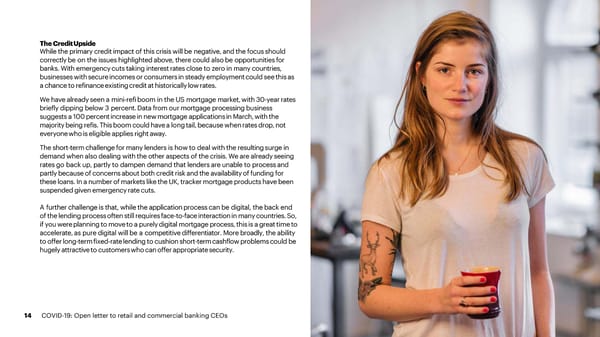The CreditUpside While the primary credit impact of this crisis will be negative, and the focus should correctly be on the issues highlighted above, there could also be opportunities for banks. With emergency cuts taking interest rates close to zero in many countries, businesseswithsecureincomesorconsumersinsteadyemploymentcouldseethisas achancetorefinanceexistingcreditathistoricallylowrates. We have already seen a mini-refi boom in the US mortgage market, with 30-year rates briefly dipping below 3 percent. Data from our mortgage processing business suggestsa100percentincreaseinnewmortgageapplicationsinMarch,with the majoritybeingrefis.Thisboomcouldhavealongtail,becausewhenratesdrop,not everyonewhoiseligibleappliesrightaway. The short-term challenge for many lenders is how to deal with the resulting surge in demand when also dealing with the other aspects of the crisis. We are already seeing rates go back up, partly to dampen demand that lenders are unable to processand partly because of concerns about both credit risk and the availability of funding for these loans.In a number of markets like the UK, tracker mortgage products have been suspended given emergency rate cuts. A further challenge is that, while the application process can be digital, the back end of thelendingprocessoftenstillrequiresface-to-faceinteractioninmanycountries.So, if youwereplanningtomovetoapurelydigitalmortgageprocess,thisisagreattimeto accelerate, as pure digital will be a competitive differentiator. More broadly, the ability toofferlong-termfixed-ratelendingtocushionshort-termcashflowproblemscouldbe hugelyattractivetocustomerswhocanofferappropriatesecurity. 14 COVID-19: Open letter to retail and commercial banking CEOs
 How Banks Can Manage the Business Impact: COVID-19 Page 13 Page 15
How Banks Can Manage the Business Impact: COVID-19 Page 13 Page 15